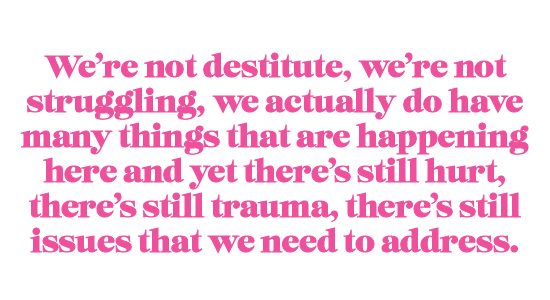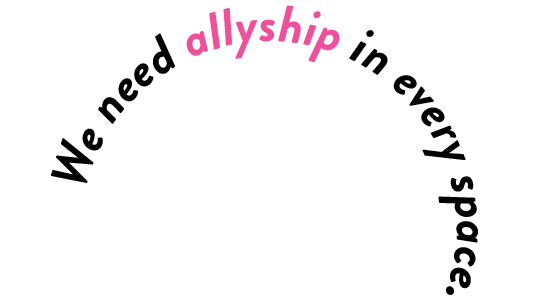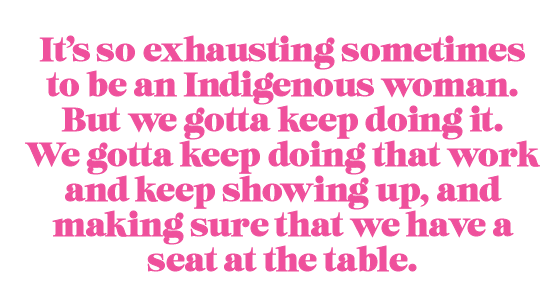Food Sovereignty Among Indigenous Women

Indigenous women in Oklahoma and beyond are leading the food sovereignty movement for their communities’ emotional, physical, and spiritual health. Food sovereignty, defined as a community’s right to have autonomy over their food systems, encompasses a wide range of initiatives, from seed-saving projects to youth agricultural programs and “first food” or human milk promotion. [1] While improving health is a central goal, the movement also seeks to restore cultural knowledge, practices, and relationships with the land, to propagate healing in Indigenous communities from historical trauma.
Colonial violence and its legacies led to tribes’ dependence on U.S. government rations for food and the loss of traditional food knowledge and practices. With the Indian Removal Act of 1830, signed by President Andrew Jackson, thousands of Indigenous peoples were forcefully removed from their lands and relocated to “Indian Territory,” which included nearly all of Oklahoma, as well as surrounding lands. [2] Forced removal disrupted Indigenous peoples’ connections with the land, while assimilation tactics such as “civilizing” boarding schools for Indigenous children hindered the transmission of cultural knowledge through generations. [3] The aftereffects of these and other forms of continued settler violence live on in the lands and bodies of Indigenous people today.
Historical destruction of traditional food systems and economies is manifested today in the high rates of food insecurity among Indigenous communities. Food insecurity encompasses both the availability and the nutritional quality of food, and research shows that it disproportionately affects marginalized communities. In a study of American Indians in rural Oklahoma, 56% of those surveyed reported inadequate food quantity and 62% reported inadequate food quality. [4] The lack of nutritional, affordable food in tribal communities is tied to high rates of diabetes and obesity among community members. In Indigenous American populations in Oklahoma, the rates of obesity (40.6%), high blood pressure (40.1%), and type 2 diabetes (16.7%) greatly exceed those of the U.S. general population. [5] These significant disparities underscore the importance of Indigenous women and Two Spirits’ work in leading the food sovereignty movement to restore their communities’ health.
U.S. Food and agriculture policy has a significant impact on the food systems of Indigenous communities and, consequently, their health. One far-reaching piece of federal legislation impacting the food sovereignty movement is the Farm Bill, passed approximately every five years by the United States Congress. The Farm Bill addresses nutrition programs, agricultural policies, food production, natural resource conservation, rural development, and insurance programs, among others. [6] In 2018, the Farm Bill offered unprecedented opportunities to Indigenous communities, specifically around advancing their food sovereignty and security efforts, agricultural production operations, economic and workforce development initiatives, and public health priorities. [7]
Today, Oklahoma has 39 federally recognized tribes, [8] each with their own relationship to and practices surrounding food, though shared experiences exist. Food sovereignty programs in the state include the Osage Nation’s programs to promote traditional foods among elementary schools; [9] the Muscogee (Creek) Nation’s Mvskoke Food Sovereignty Initiative, [10] which encompasses a wide range of projects related to the growth, recovery, and promotion of traditional foods; and the Pawnee Seed Preservation Project [11] and Cherokee Nation Seed Bank, [12] which each preserves and grows traditional seeds.
In the following stories, individuals shed light on their lived experiences surrounding food sovereignty within their lives and the lives of their communities. They explore the role food plays and the impact it can have on the livelihoods of Indigenous people, specifically uncovering the interconnectedness of food and women. Food Sovereignty goes beyond physical food, it is connected to emotional, mental, and spiritual well-being. Bare witness as Indigenous women dream of a food sovereign Oklahoma and beyond.
Food Sovereignty Among Indigenous Women

Indigenous women in Oklahoma and beyond are leading the food sovereignty movement for their communities’ emotional, physical, and spiritual health. Food sovereignty, defined as a community’s right to have autonomy over their food systems, encompasses a wide range of initiatives, from seed-saving projects to youth agricultural programs and “first food” or human milk promotion. [1] While improving health is a central goal, the movement also seeks to restore cultural knowledge, practices, and relationships with the land, to propagate healing in Indigenous communities from historical trauma.
Colonial violence and its legacies led to tribes’ dependence on U.S. government rations for food and the loss of traditional food knowledge and practices. With the Indian Removal Act of 1830, signed by President Andrew Jackson, thousands of Indigenous peoples were forcefully removed from their lands and relocated to “Indian Territory,” which included nearly all of Oklahoma, as well as surrounding lands. [2] Forced removal disrupted Indigenous peoples’ connections with the land, while assimilation tactics such as “civilizing” boarding schools for Indigenous children hindered the transmission of cultural knowledge through generations. [3] The aftereffects of these and other forms of continued settler violence live on in the lands and bodies of Indigenous people today.
Historical destruction of traditional food systems and economies is manifested today in the high rates of food insecurity among Indigenous communities. Food insecurity encompasses both the availability and the nutritional quality of food, and research shows that it disproportionately affects marginalized communities. In a study of American Indians in rural Oklahoma, 56% of those surveyed reported inadequate food quantity and 62% reported inadequate food quality. [4] The lack of nutritional, affordable food in tribal communities is tied to high rates of diabetes and obesity among community members. In Indigenous American populations in Oklahoma, the rates of obesity (40.6%), high blood pressure (40.1%), and type 2 diabetes (16.7%) greatly exceed those of the U.S. general population. [5] These significant disparities underscore the importance of Indigenous women and Two Spirits’ work in leading the food sovereignty movement to restore their communities’ health.
U.S. Food and agriculture policy has a significant impact on the food systems of Indigenous communities and, consequently, their health. One far-reaching piece of federal legislation impacting the food sovereignty movement is the Farm Bill, passed approximately every five years by the United States Congress. The Farm Bill addresses nutrition programs, agricultural policies, food production, natural resource conservation, rural development, and insurance programs, among others. [6] In 2018, the Farm Bill offered unprecedented opportunities to Indigenous communities, specifically around advancing their food sovereignty and security efforts, agricultural production operations, economic and workforce development initiatives, and public health priorities. [7]
Today, Oklahoma has 39 federally recognized tribes, [8] each with their own relationship to and practices surrounding food, though shared experiences exist. Food sovereignty programs in the state include the Osage Nation’s programs to promote traditional foods among elementary schools; [9] the Muscogee (Creek) Nation’s Mvskoke Food Sovereignty Initiative, [10] which encompasses a wide range of projects related to the growth, recovery, and promotion of traditional foods; and the Pawnee Seed Preservation Project [11] and Cherokee Nation Seed Bank, [12] which each preserves and grows traditional seeds.
In the following stories, individuals shed light on their lived experiences surrounding food sovereignty within their lives and the lives of their communities. They explore the role food plays and the impact it can have on the livelihoods of Indigenous people, specifically uncovering the interconnectedness of food and women. Food Sovereignty goes beyond physical food, it is connected to emotional, mental, and spiritual well-being. Bare witness as Indigenous women dream of a food sovereign Oklahoma and beyond.
Narrative #1
“Living My Best Decolonial Life”
It’s a really interesting and varied experience living as a person in Oklahoma, as a Native person, as a Two Spirit or a gender-variant person, who is trying to live their best decolonial life. I’m somebody who has a lot of history, to a variety of homelands, within what is called the United States. I’m an inter-tribal person and that is all brought with me as I’m here in my current motherland.

First Foods, Birth Work, and Food Sovereignty
I’m a first food advocate, [and first food] is basically the milk that I produce as a human, when I was doing that actively. It’s not just nutrition, it’s not just the nuts and bolts of growing and ensuring that this human is developing, it’s also medicine in the ways that it’s healing across generations—which is researched. And that in and of itself is food sovereignty—the first practice of food sovereignty. Because that ability to care for our babies has been greatly disrupted in very drastic and traumatic ways, due in part to the acts of policy against Indigenous people. With that, they also disrupted our actual food systems.
In our Seminole language, to describe first food, like lactation or human milk, it’s the same word for corn. A lot of the communities I come from have corn as part of the main component, not just of our diet, but also in our ceremonies, in our practices. Food sovereignty also encompasses culture and language, ceremony, song, ritual. It’s life-giving, just as I am, just as those matriarchs or those people who can carry life. It really is paramount to communities, not just survival but to our livelihood, to our economies at one point or various points. It’s more than just growing food, protecting seeds, saving seeds—it ensures the integrity of our communities, of our tribes.
I’m a birth worker, a community role that is not widely practiced. As I have participated in this food sovereignty effort with all these women and femmes, the innate calling that I have as a birth worker has just become louder and louder. And as I grow in my role, I also hear other things being said to me, related to these other roles that a birth worker had. You call back one practice or one role, it brings back an abundance of others. And that’s more space being made for the benefit of reclamation of our sovereignty as tribal nations.
Women’s Roles in Food Sovereignty
In the particular community that I’m residing in, a lot of the folks that are behind the food sovereignty and seed sovereignty efforts are women or femmes. There is some direction by the chief’s council, which is made up of men. However, in terms of the actual work, the actual effort—it’s been on the women and the femmes to keep this going, to organize the seed varieties that are being grown, where they’re being grown, as well as even the harvesting.
We’ve done our own fundraising. We’ve also found our own donors. It’s not an initiative that has been created by the tribal government itself. It is its own project, yet it’s the only one in existence right now within the Pawnee nation. So without these matriarchs, where would it be? Would we even be up to twelve varieties now of the hundreds, if not thousands, we used to have?

It’s a very large effort and sometimes undervalued effort, when we think about who’s doing this caregiving type of work. Growing or resurrecting seeds that only know the motherland and not this Oklahoma soil, trying to get volunteers to help you, trying to get an actual facility to store the seeds, to do seed preparation, and to see how little other Pawnee men are involved. Honestly, to see how few Pawnee people are involved. I am not trying to bag on my tribal community at all. I just see how hard it can be to be a grower, to be a gardener.
A lot of times there’s quotes that talk about women being the backbone of our communities and I almost think that that’s a detriment to us and our work. It’s almost like we’re taken advantage of, even made to be martyrs. It’s almost like the romanticism of resilience, right? Some of us, as we are called resilient, are like, “But our resilience is not the same as others’ resilience.” Somebody could have survived bank foreclosure and we survived near mass-genocide. So it’s just very interesting to look at the importance that women and femmes are to this movement, to this effort, and then just the kind of limited support, the limited value that these roles get.

Coming together in food sovereignty is re-cultivating that matriarchy, a sisterhood. It’s that community of feminine energy that some of us don’t always get, especially when you’re on the margins, in rural communities. It can be really hard to find that. A lot of these elders in other spaces, in other inter-tribal spaces, have said that it’s the time of the woman, the feminine. That’s what’s really going to bring us forward as we face new challenges.

Cultural Dimensions of Food Sovereignty
I was just talking with a cousin the other day about fry bread, gravy, basically ration food. And she was so hard on herself because in our communities fry bread is a hot commodity, if you will, and people will want to know who made the bread, especially if the texture’s off, or just little subtle ways you can tell, like, “Hm, I don’t know about this bread.” And I was like, “You’re really holding yourself to a high standard on this ration food.” This was survival food, this was not Indigenous food. This was food that was part of the government handouts to our tribal nations when they starved us or uprooted us and forced us on to these lands that we’re on now. So it’s interesting that we, in some ways, have made that our own but also have subverted our own connections to our original foods, our original seeds.
I think that many of our communities have so much to gain, so much to learn, in food sovereignty. There’s so many connections to all these other facets of culture, that even might not be actively practiced in the present time. I know that some food is involved in coming of age ceremonies. And there are a lot of tribes that don’t currently practice those ceremonies. They might not even have the songs on the drum anymore, or anybody living who could sing them. They might not have even the language to use to know how those ceremonies used to go. Even what food was part of that process. But I don’t think that anything is permanently gone; I think that we just have to call it back. When our tribes are able to dig into something such as food sovereignty, they’re actually pulling out a lot more than just seeds, than just crops to plant. They’re pulling out these themes of balance, of health, of wellness.

One of the initial goals of the seed project here was to bring back seeds, enough seeds that we can start sharing seeds, so that we can create other growers. And once that happened, it was like, we want to be able to feed our people at ceremonies, we want to be able to put that food out for the people. So if they never grew the food before at least they’ll have eaten or tasted home Pawnee corn. That’s happened a few times.
Now we want to create seed-keepers, and bundle keepers as well. Our Pawnee people used to carry or create these bundles, [which are] sacred bundles of our religion or our faith practices for a variety of events. Some of these were kept in the families, like the families would have their own bundles. What I understood, what I was taught, is that they are living. They are always meant to be carried on, and fed. In removal, or in the onslaught of the attacks in our ancestral homelands, a lot of these bundles got buried with relatives or ancestors, or they got sent or taken by museums. Some of them—they’re just out there. It’s a profound feeling to feel like part of you is just everywhere. Especially when you know where these bundles are. We have agreements with museums where they’re being kept and when we are kind of near them, what you feel is unlike any other.
Policy Visions
I want land back, like some legislative effort to provide more land or recognize the consequences of treaties still existing. I was reading how the Supreme Court ruling on Creek Nation jurisdiction last summer could potentially impact New York State tribes, where they might use that ruling to access some of their land that they never ceded in their treaties. How wonderful would it be if all this land is finally recognized in this lawful way, and we’re able to cultivate our own? Like we’re given our land back and we can use it to cultivate or grow.
I mean, that’s already supposed to be honored, right? I don’t know if there’s a legislative effort that would enforce that. I know there’s current folks on the ground that are trying to legislate against the Supreme Court ruling. Typically that’s what happens in our history with federal Indian policy—if we get a Supreme Court ruling in our favor, then all of a sudden people get fear raised in them, and then they want to come back and legislate that, reducing the gains that could be made.
We have a relationship to land not to contour or conform the land to us, but to live with the resource, live with the abundance, and I would look at policies that also reflect that. I’m thinking about the wildfires in California and how those Native nations, in their time, when they had full complete control of the land they were occupying, had already had practices in place to reduce the brush that would cause [the wildfires]. And because of settlers coming in and creating laws to prevent Native nations from even foraging their own medicines and roots and plants, they were prevented from continuing to practice that kind of maintenance of the land. And now you’ve got the abundance of wildfires as well as people living in places they probably shouldn’t be living in. That’s something that I would like to see here in Oklahoma—trusting the initial caretakers to do what we need to do. I mean, we already are.
Future Directions
The youth component [of the food sovereignty movement] is becoming louder and louder. I see these young single Pawnee moms, these younger up-and-coming Pawnees who might be in college, these teens, these kids in high school or middle school, even my own children, who have their hands in the soil and are learning these ways. Whether or not they’re actively like, “this is what I’m going to do for the rest of my life,” this exposure is so necessary because then it just becomes so normal, right? This is just what we do. It’s not a chore or a drag, or like, “what are they doing?”

That’s the future I see—more of our young people coming into the effort. More of these people turning into seed-keepers; more of these seed-keepers turning into bundle-keepers. More medicine people coming into their own, realizing their full potential. And maybe we start addressing misogyny and patriarchy and bigotry, homophobia and transphobia, because that is here in this community. All this hurt caused by these larger systems that have everything to do with white supremacy and capitalism.
We’re not destitute, we’re not struggling, we actually do have many things that are happening here and yet there’s still hurt, there’s still trauma, there’s still issues that we need to address. How do we address those? And how do we bring abundance, so people are able to live in that abundance? We will do things as our ancestors have done in order to not just live our lives but to continue to bring our communities, our culture forward.

Narrative #2
"The Seeds Found Me”
I work with the Pawnee Seed Preservation Society. We started out as the Pawnee Seed Preservation Project. This project has been ongoing for about 20+ years. It originally started out as a call-out for the families whose ancestors had walked from Nebraska to present-day Pawnee, Oklahoma, where we’re located. [The call] was to see what seeds we still had, and what families still had the seeds. We had a seed blessing, and we started rematriation [of] our seeds and started working towards what we have today, [which] is a huge seed bank. We revitalized varieties of corn that we hadn’t seen since our ancestors walked through Nebraska.
Corn is very significant to the Pawnee people. It’s a part of our creation story. Whenever Tirawa or the heavens created man and woman, the first gift they gave them was corn. So, a lot of our ceremonies center around that. When people say, “Oh, it’s just corn,” I’m like, “No it’s not. It’s our creation story. It’s a ceremony. It’s a song. It’s language.”
I got involved with the Pawnee Seed Preservation Society about five years ago. It was like the seeds found me. That’s what I always tell people—the seeds found me. I went to the seed blessing that the Seed Society had, and I ended up doing my college internship with the Pawnee Seed Preservation Society in our motherland of Nebraska. I’m very fortunate to have been able to be in this space that my ancestors prayed in, that they sang in, that they planted seeds in.

Right now, my current role with the Pawnee Seed Preservation Society is just remembering more about what our women used to do, thinking about songs, creating songs, [and] creating space for our young girls to get involved in seed work prior to becoming women. The seed work wasn’t something I grew up around. So it’s new to me, too. But [I’m] trying to create those spaces to let our girls get involved sooner.
Women’s Roles in Food Sovereignty
We leave out breastfeeding as the original form of food sovereignty. We are the original food sovereigntists. For a lot of our Indigenous creation stories, the women were the caretakers of the seeds. They were the ones blessing the seeds and planting the seeds and tending the gardens. That was a big role for our women that was reversed when colonization started happening. Our women have a huge, significant role in making food not only as mothers, but also planting food and being the caretakers of food gardens.
It’s so exhausting sometimes to be an Indigenous woman. But we gotta keep doing it. We gotta keep doing that work and keep showing up, and making sure that we have a seat at the table.

Food Sovereignty and Health
Food sovereignty, to me, means remembering and reconnecting. Another word I would use is decolonizing. It’s not only that it’s a reconnection to land, [but it’s also] a reconnection to language, to ceremony, to overall health. People don’t realize the impact of how we grow things, how it impacts our soil. We have to have good soil to have things grow, and we have to have a good water system. We have to have all of these things in place to have really good food, and really good life sources to continue to thrive.
Everybody can have a hand in food sovereignty. It impacts so many different aspects of our communities that people don’t even realize. And it’s very healing work as well. I’m a recovering addict [and] I am a multiple trauma survivor, from sexual assault and domestic violence. Our women learn how to heal themselves in this work, too. So it can be used for mental health.
The issue is trying to get people to understand that. They’re just like, “Oh, well, it’s just corn.” Or, “Oh, you’re just planting a garden.” A garden is a lot of physical work. It’s also so good for your emotional health and for your mental health, so good for your body. It’s like my aunt always says, “If you want a good workout, go spend an hour in your garden. Pull weeds, make mounds, water your garden.” You’re getting so much more than just the physical part of it.
It’s taken 25 years to get where we are, and we’re still trying to break through to our communities so they can understand the importance of food sovereignty and how it’s not just about what we’re putting into our bodies, [but] it’s about the work that’s going into it, and the overall benefit to our health.
Healing through Food Sovereignty
A lot of my heart work is around mental and behavioral health. I know those systems ‘cause I’ve been a part of them. I advocate in a lot of those spaces and it’s really hard to go up against people who have really high degrees, to make them think outside of the box that they’re given. What I see is a lot of, “We’re here to treat symptoms, [but] not so much overall health.” I would love to see more holistic approaches to healing.
I’m not saying anything bad against medicated assisted treatment. I’m just saying, what about this too? What about this option? As somebody who was prescribed medication for anxiety, I became highly addicted to it, and it really took my life downhill fast. So, I can’t take those types of medications. A lot of people who are addicts or who have those addictive personalities can’t take those types of medications.

With a lot of mental and behavioral health problems, there’s underlying trauma that needs healing. I think any programs that are working with victims of trauma need to be growing a garden. You need to have a garden in your life. You need to be spending time in the earth. Let’s talk about our land, let’s plant some gardens, let’s have more physical activity, so we can feel better and be better.
A lot of times, Indigenous communities aren’t ready for talk therapy. We grew up with this historical intergenerational trauma, and so a lot of times we’re taught not to talk about things: “We don’t talk about that; it’s not to be brought up.” We see ourselves picking up a lot of those habits because that’s so ingrained into our family systems. There’s a huge stigma around talk therapy. Like, nobody wants to see you going into behavioral health. It’s like, “Why is the behavioral health department all the way at the end of the clinic, where everybody sees me walking back there? I don’t want to go.” Or, “I’m not going to do that. That’s for crazy people.” So until we can get away from that stigma, we need to be able to have something in place for people to still be able to heal.
Well, let’s start in the garden. Let’s start here. Just spending that little bit of time out there in the garden, in the sun, in the elements, and doing all of that work is so healing. And then it’s like, “Okay, now let’s inch our way towards talk therapy.” Cause I’m a huge advocate for talk therapy too, [but] I just know it’s not always the first choice.

Future Dreams and Visions
My dream is for our communities to be more accepting of food sovereignty. It’s such a healthy way of life, and it could help us all thrive. Not just Indigenous communities, but the communities outside of us that we would collaborate with. One of my favorite things about working with the Pawnee Seed Preservation Society is the allyships that we build with non-Indigenous communities. We have a lot of really great partners in this project that help us continue to do the work.
I want to continue to see that work happening in all of these communities. I would love to see all of that happening—the acceptance, the advocating, the healthy living, the healthy thriving.
Takeaway Thoughts
Be supportive of the food sovereignty movement. Know that it impacts us all. It’s not just women’s work. We need allyship in every space. It’s not just Indigenous allies—we need non-Indigenous allies too. Support the work, support breastfeeding, support agriculture. Understand the impact that good agriculture has on our soil and how it affects everything. If we don’t have good soil, we can’t grow things. One of my favorite things that one of our gardeners, one of our allies told me, was, “The only way you can be a bad gardener is by not growing anything.” That’s what I would leave people with.


Organization Spotlight:
Pawnee Seed Preservation Society
When the Pawnee tribe lived in present day Nebraska, they grew corn to sustain their community. The Tribe had developed a great knowledge on how to care for and grow Pawnee corn. Much of the knowledge and the seeds were lost in the move to Oklahoma. The Pawnee Seed Preservation Society works to create a movement around revitalizing the knowledge and runs a seed bank so that native Pawnee corn can once again be a part of their lives. “Each seed has a story and each seed has a prayer.”
1 Devon A. Mihesuah and Elizabeth Hoover, eds., Indigenous Food Sovereignty in the United States: Restoring Cultural Knowledge, Protecting Environments, and Regaining Health (Norman: University of Oklahoma Press, 2019).
2 Devon Mihesuah, “Searching for Haknip Achukma (Good Health): Challenges to Food Sovereignty Initiatives in Oklahoma,” American Indian Culture and Research Journal 41, no. 3 (2017): pp. 9-30, https://doi.org/10.17953/aicrj.41.3.mihesuah.
3 Ibid
4 Valarie Blue Bird Jernigan et al., “Food Insecurity and Chronic Diseases among American Indians in Rural Oklahoma: The Thrive Study,” American Journal of Public Health 107, no. 3 (March 2017): pp. 441-446, https://doi.org/10.2105/ajph.2016.303605.
5 Charlotte V Love et al., “Diabetes and Obesity Associated with Poor Food Environments in American Indian Communities: The Thrive Study,” Current Developments in Nutrition 3 (December 5, 2018): pp. 63-68, https://doi.org/10.1093/cdn/nzy099.
6 “The Farm Bill and Indian Country: Assessing the Present and Looking Ahead (Policy Recommendations for the Federal Government)” (National Congress of American Indians, December 2020), https://www.ncai.org/farmbillbrief.pdf.
7 Ibid
8 Devon Mihesuah, “Searching for Haknip Achukma (Good Health): Challenges to Food Sovereignty Initiatives in Oklahoma,” American Indian Culture and Research Journal 41, no. 3 (2017): pp. 9-30, https://doi.org/10.17953/aicrj.41.3.mihesuah.
9 “Tribal Governance Innovation Spotlight (Food Sovereignty): Osage Nation.” (National Congress of American Indians, 2020), https://www.ncai.org/ptg/Osage.Nation.Case.Study.pdf.
10 Elizabeth M Hoover, “Mvskoke Food Sovereignty Initiative (MFSI), Muscogee Creek Nation, Okmulgee OK,” From Garden Warriors to Good Seeds: Indigenizing the Local Food Movement, June 8, 2014, https://gardenwarriorsgoodseeds. com/2014/06/08/mvskoke-food-sovereignty-initiative-mfsi-muscogee-creek-nation-okmulgee-ok/.
11 Deb Echo-Hawk, “Pawnee Seed Preservation Project Title VI Elder Meals Program,” Seeds of Native Health, n.d., https:// seedsofnativehealth.org/wp-content/uploads/2019/02/Deb-PowerPoint-2018-compressed.pdf.
12 “Cherokee Nation Seed Bank ,” Cherokee Nation Seed Bank , n.d., https://secure.cherokee.org/SeedBank/Home/Index.


